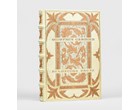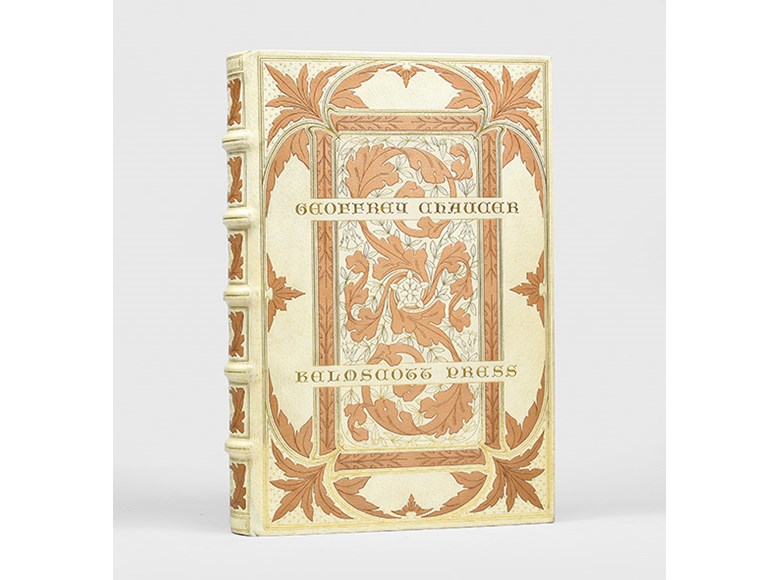 BACK TO GALLERY
BACK TO GALLERY
Peter Harrington
Geoffrey Chaucer.
The Works, now newly imprinted.
The masterpiece of the Kelmscott Press in a fine contemporary binding by Paul Claessens
Folio (425 x 285 mm).
description
Limited edition, one of 425 copies on paper. A magnificent copy of Morris’s masterpiece in a fine and entirely appropriate contemporary pigskin binding, recorded as “unlocated” in the census.
The first known owner of this copy was the Belgian politician and banker, Théophile Charles André de Lantsheere (1833-1918). After obtaining a doctorate in law, he practised as an advocate in Brussels before serving as Minister of Justice 1871-78. For over a decade he was president of the Chamber of Representatives before serving in the Belgian senate. From 1890 he was director of the National Bank of Belgium and, in 1905, became governor.
At the turn of the 20th century, Brussels had become a focal point for the arts and crafts movement. Lantscheere presumably commissioned the distinguished bookbinder Paul Claessens (1861-1909) to bind this copy in an appropriate design. Claessens, advertising himself as a bookbinder and gilder was, around the 1890s, operating from 43 rue des Comédiens, Brussels.
The archives for the Claessens firm are now held by Bibliotheca Wittockiana, the Book Arts and Bookbinding museum in Brussels. They hold two drawings which both carry the number 598. This is presumably a bindery job number. The first is a pencil drawing showing the design (and revealing that the spine decoration was slightly revised). The second drawing is a template guide which was laid on the book itself and marked in blind before the addition of gilt. This second drawing carries many numerical annotations which note the types of gouges to be used.
In 1978 Colin Franklin noted that the binding was “an entirely appropriate binding for the Kelmscott Chaucer, a rare event indeed, by a binder of great distinction... I would say that this is an art nouveau binding absolutely in sympathy with Burne-Jones’s illustrations and the Morris borders. It came to me with a tradition that Burne-Jones was connected with the design but I have no supporting evidence”.
The use of pigskin recalls the magnificent Cobden-Sanderson bindings of the Kelmscott Chaucer executed at the Doves Bindery. Indeed, the grandeur of this binding finds an obvious comparison in Cobden-Sanderson’s own copy, sold to the Duke of Marlborough, later part of The Garden Collection and acquired by Sir J. Paul Getty in 1989 for his Wormsley Library.
This copy was first offered for sale at auction in December 1929. From the auction catalogue description, “a complete set of Kelmscott Press books including a magnificent ‘Chaucer’ is a special white pigskin binding, the property of Vicomte de Lantsheere”, we know that Lantsheere was a dedicated collector of Kelmscott books.
The Kelmscott Chaucer was the result of close collaboration between Morris and Burne-Jones over four years. Morris designed the watermark for the paper, which was copied from an Italian incunable in his own collection and made entirely of linen by Batchelor. It took several requests before the Clarendon Press granted permission to use Skeat’s new edition of Chaucer for the text. Burne-Jones spent his Sundays on the book’s 87 illustrations, working long hours in fear that Morris, whose health deteriorated alarmingly, might die before the project was finished. Burne-Jones’s delicate pencil drawings were photographed by Emery Walker’s firm and the young Birmingham artist Robert Catterson-Smith worked over them in Chinese white and Indian ink, rendering them more like woodcuts. The designs were then transferred to wooden blocks and engraved by William Harcourt Hooper. The book was completed just before Morris's death. Burne-Jones called it “a pocket cathedral it is so full of design”, and “the finest book ever printed; if W.M. had done nothing else it would be enough.”
W. B. Yeats described it as “the most beautiful of all printed books” and F. S. Ellis, the editor, stated it was “the grandest book that has issued from the press since the invention of typography”. “The Kelmscott Chaucer is not only the most important of the Kelmscott Press’s productions; it is also one of the great books of the world. Its splendour can hardly be matched among the books of the time” (Ray, The Illustrator and the Book in England).
The first known owner of this copy was the Belgian politician and banker, Théophile Charles André de Lantsheere (1833-1918). After obtaining a doctorate in law, he practised as an advocate in Brussels before serving as Minister of Justice 1871-78. For over a decade he was president of the Chamber of Representatives before serving in the Belgian senate. From 1890 he was director of the National Bank of Belgium and, in 1905, became governor.
At the turn of the 20th century, Brussels had become a focal point for the arts and crafts movement. Lantscheere presumably commissioned the distinguished bookbinder Paul Claessens (1861-1909) to bind this copy in an appropriate design. Claessens, advertising himself as a bookbinder and gilder was, around the 1890s, operating from 43 rue des Comédiens, Brussels.
The archives for the Claessens firm are now held by Bibliotheca Wittockiana, the Book Arts and Bookbinding museum in Brussels. They hold two drawings which both carry the number 598. This is presumably a bindery job number. The first is a pencil drawing showing the design (and revealing that the spine decoration was slightly revised). The second drawing is a template guide which was laid on the book itself and marked in blind before the addition of gilt. This second drawing carries many numerical annotations which note the types of gouges to be used.
In 1978 Colin Franklin noted that the binding was “an entirely appropriate binding for the Kelmscott Chaucer, a rare event indeed, by a binder of great distinction... I would say that this is an art nouveau binding absolutely in sympathy with Burne-Jones’s illustrations and the Morris borders. It came to me with a tradition that Burne-Jones was connected with the design but I have no supporting evidence”.
The use of pigskin recalls the magnificent Cobden-Sanderson bindings of the Kelmscott Chaucer executed at the Doves Bindery. Indeed, the grandeur of this binding finds an obvious comparison in Cobden-Sanderson’s own copy, sold to the Duke of Marlborough, later part of The Garden Collection and acquired by Sir J. Paul Getty in 1989 for his Wormsley Library.
This copy was first offered for sale at auction in December 1929. From the auction catalogue description, “a complete set of Kelmscott Press books including a magnificent ‘Chaucer’ is a special white pigskin binding, the property of Vicomte de Lantsheere”, we know that Lantsheere was a dedicated collector of Kelmscott books.
The Kelmscott Chaucer was the result of close collaboration between Morris and Burne-Jones over four years. Morris designed the watermark for the paper, which was copied from an Italian incunable in his own collection and made entirely of linen by Batchelor. It took several requests before the Clarendon Press granted permission to use Skeat’s new edition of Chaucer for the text. Burne-Jones spent his Sundays on the book’s 87 illustrations, working long hours in fear that Morris, whose health deteriorated alarmingly, might die before the project was finished. Burne-Jones’s delicate pencil drawings were photographed by Emery Walker’s firm and the young Birmingham artist Robert Catterson-Smith worked over them in Chinese white and Indian ink, rendering them more like woodcuts. The designs were then transferred to wooden blocks and engraved by William Harcourt Hooper. The book was completed just before Morris's death. Burne-Jones called it “a pocket cathedral it is so full of design”, and “the finest book ever printed; if W.M. had done nothing else it would be enough.”
W. B. Yeats described it as “the most beautiful of all printed books” and F. S. Ellis, the editor, stated it was “the grandest book that has issued from the press since the invention of typography”. “The Kelmscott Chaucer is not only the most important of the Kelmscott Press’s productions; it is also one of the great books of the world. Its splendour can hardly be matched among the books of the time” (Ray, The Illustrator and the Book in England).






 SEND AN EMAIL
SEND AN EMAIL